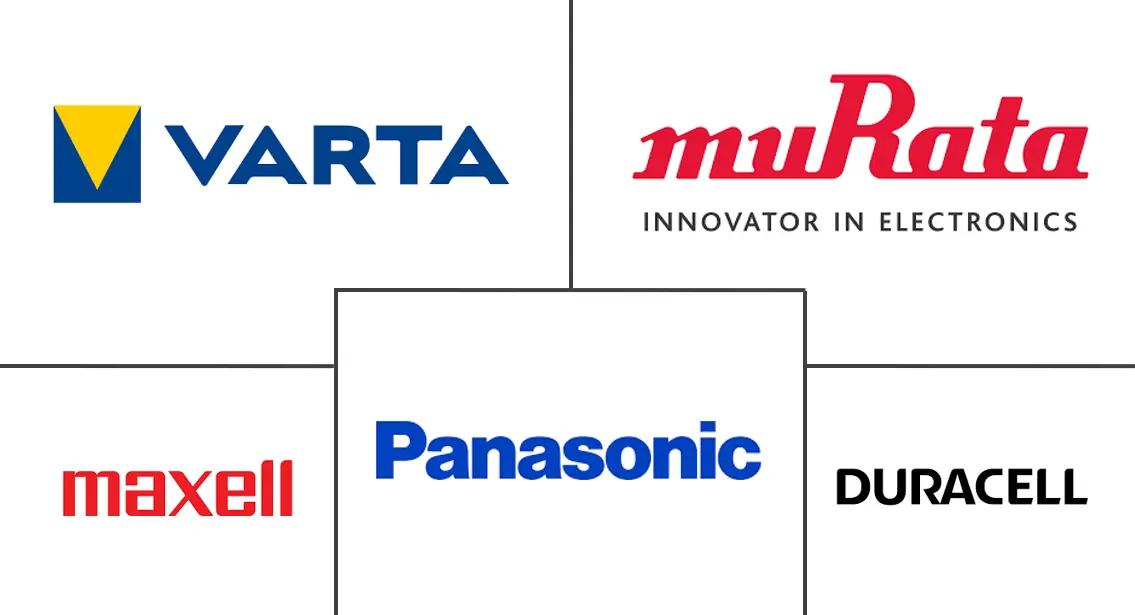South America Micro Battery Market Size and Share
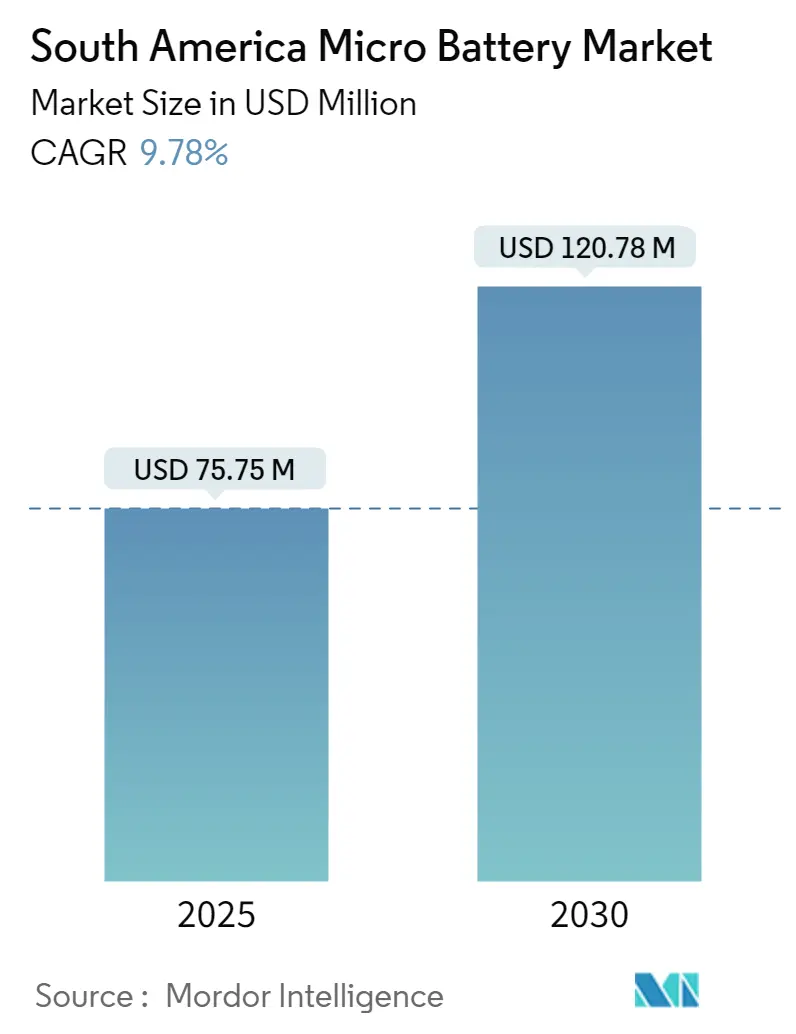
South America Micro Battery Market Analysis by Mordor Intelligence
The South America Micro Battery Market size is estimated at USD 75.75 million in 2025, and is expected to reach USD 120.78 million by 2030, at a CAGR of 9.78% during the forecast period (2025-2030).
- Over the medium term, the rising adoption of portable devices and flexible & lightweight design are expected to drive the demand for micro batteries during the forecast period.
- On the other hand, competition from other battery types, such as cylindrical, can significantly restrain the growth of the South American micro battery market.
- Nevertheless, the growing technological innovations in micro batteries across wearable devices like smartwatches, wireless earphones, smart bands, and more are expected to create significant opportunities for micro battery market players in the near future.
- Brazil is anticipated to dominate the South American micro battery market during the forecast period due to growing demand for consumer electronics.
South America Micro Battery Market Trends and Insights
Competition from Established Battery Technology Restrain the Market Growth
- The growth of the micro battery market in South America faces several challenges, primarily due to competition from established battery technologies like lithium-ion and lead-acid batteries. This established dominance poses a significant restraint on the market's growth.
- Established battery technologies such as lithium-ion, nickel-cadmium (NiCd), and nickel-metal hydride (NiMH) are widely used across various applications, including consumer electronics, electric vehicles, and industrial equipment. These batteries offer high energy density, good cycle life, and a well-established manufacturing infrastructure.
- Additionally, in recent years, the price of lithium-ion batteries and cell packs has been on the decline, which has made them more attractive to end-user industries. After experiencing slight price hikes in 2022, battery prices were once again declining in 2023. The cost of lithium-ion battery packs has decreased by 14% to reach a historic low of USD 139/kWh. This reduction can be attributed to decreases in raw material and component prices, coupled with an expansion in production capacity throughout the battery value chain.
- As lithium-ion battery prices continue to decline, the countries across the region may witness a shift in micro battery usage. The cyclindrical batteries like rechargeable Lithium-Thionyl Chloride (Li-SOCl2) batteries, now more affordable, are increasingly being adopted in industrial sensors. This trend is particularly evident in remote or hazardous environments. Consequently, this shift may hinder the growth of Solid-State Micro Batteries and Zinc-Air Batteries in the foreseeable future.
- Besides, alternate battery technologies in cylindrical and prismatic type benefit from well-established manufacturing processes, supply chains, and infrastructure for mass production, distribution, and recycling. This infrastructure advantage can lower production costs, improve economies of scale, and enhance the competitiveness of alternate battery technologies relative to micro-batteries, which may still be in the early stages of commercialization and scale-up.
- In contrast, micro-batteries like lithium ion micro batteries, often specialized and produced in smaller quantities, can be more expensive. Also, the economic conditions in South America can impact the adoption of new technologies. Cost-sensitive markets may prefer established, cost-effective solutions over newer, potentially more expensive micro batteries.
- Furthermore, the growing demand for flexible and wearable electronics has led to the development of flexible microbatteries. These batteries can be integrated into devices with unconventional shapes and surfaces, such as smart clothing, fitness trackers, and foldable smartphones. This type of rising innovation is expected to restrain established battery technology during the forecast period.
- To remain competitive, micro battery manufacturers must focus on innovation, differentiation, and addressing specific market needs to carve out their niche and drive sustained growth amidst increasing competition.
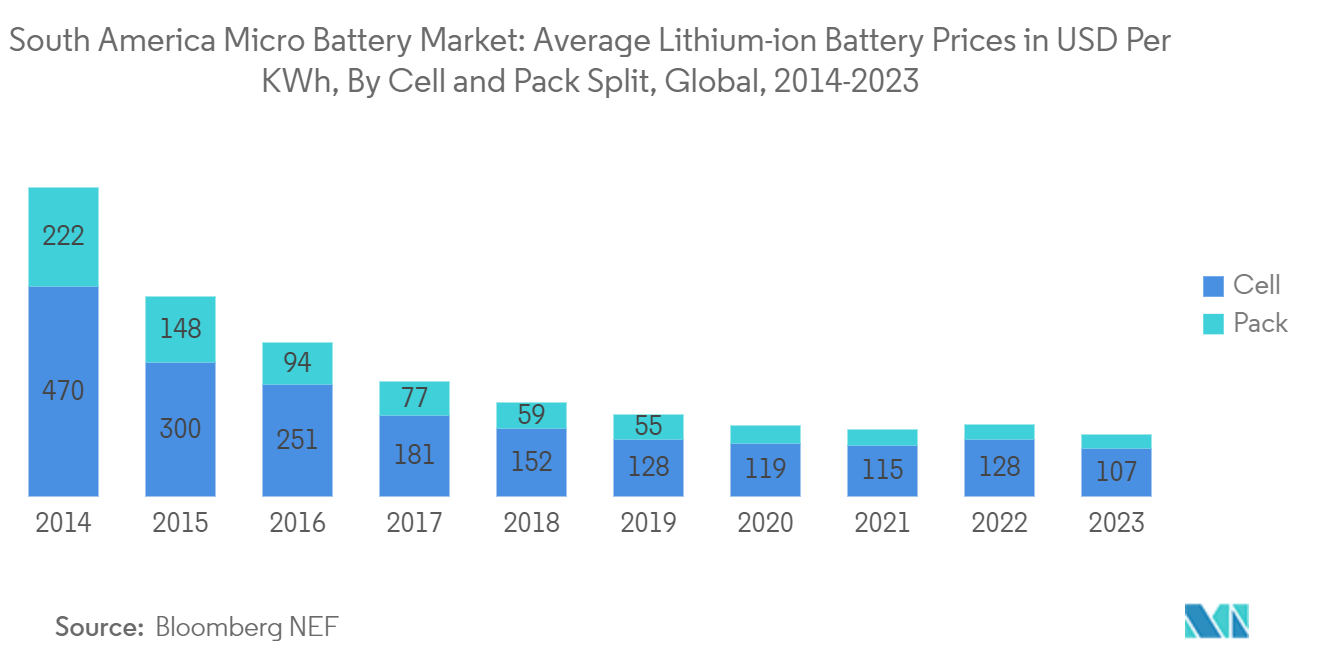
Brazil Expected to Dominate the Market
- Brazil's micro battery market is experiencing rapid growth, fueled by the surging demand for compact, efficient, and reliable power sources across diverse applications. The Consumer Electronics segment dominates the micro battery landscape, as these batteries power a myriad of devices, from smartphones and tablets to laptops and wearables.
- South America's medical industry has seen a notable uptick, particularly in Brazil. The rising diabetes diagnoses have spurred demand for continuous glucose monitoring (CGM) systems and insulin pumps. These essential medical devices rely on dependable, long-lasting micro batteries. Data from Brazil's Ministério da Saúde indicates a 10.2% uptick in diabetes diagnoses for adults in 2023, marking a 37.83% rise since 2019. With diabetic numbers projected to climb, the demand for micro batteries in medical equipment is set to surge.
- The micro battery market is witnessing a boom, largely propelled by the escalating demand for wireless earphones. The transition from wired to wireless models, especially true wireless stereo (TWS) earbuds, has intensified the need for compact, high-performance batteries. Major regional players have been rolling out cutting-edge wireless headphones, underscoring this trend.
- For example, JBL made waves in August 2024 by launching its Live Beam 3 and Live Buds 3 headphones in Brazil. These introductions not only signify JBL's strategic expansion but also highlight the integration of premium features, like noise cancellation and display-equipped cases, into their broader product lineup. Such advancements in headphones are poised to amplify the demand for micro batteries.
- Despite facing stiff competition from established battery technologies, Brazil's micro battery market is rife with opportunities. The burgeoning adoption of IoT devices—spanning smart home technologies, sensors, and connected appliances—underscores the growing relevance of micro batteries, especially for these compact, energy-efficient devices.
- Additionally, Brazil's aging population is driving a heightened demand for portable medical devices, from hearing aids and pacemakers to glucose monitors. These devices, requiring compact and reliable batteries, are becoming increasingly vital for enhancing the quality of life in the elderly. This trend, coupled with the broader demand for portable devices across industries, signals a robust opportunity for ramping up micro battery production in the region.
- Given the strong domestic demand, recent industry developments, and the establishment of new manufacturing plants, Brazil's micro battery market is poised for significant growth in the coming years.
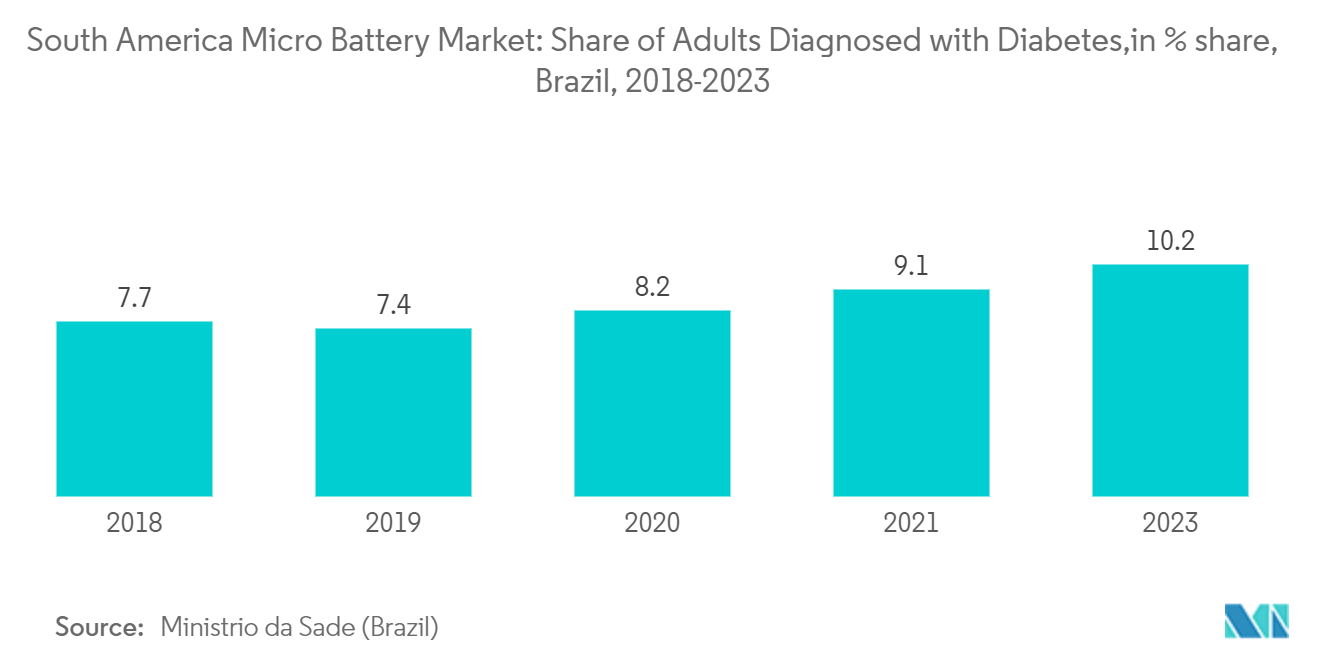
Competitive Landscape
The South American micro Battery is semi-fragmented. Some of the key players (not in particular order) are Duracell Inc., Panasonic Holding Corporation, Maxell, Ltd., Varta AG, Murata Manufacturing Co., Ltd., among others.
South America Micro Battery Industry Leaders
-
Maxell, Ltd
-
Murata Manufacturing Co., Ltd.
-
Panasonic Holding Corporation
-
Duracell Inc.
-
Varta AG
- *Disclaimer: Major Players sorted in no particular order
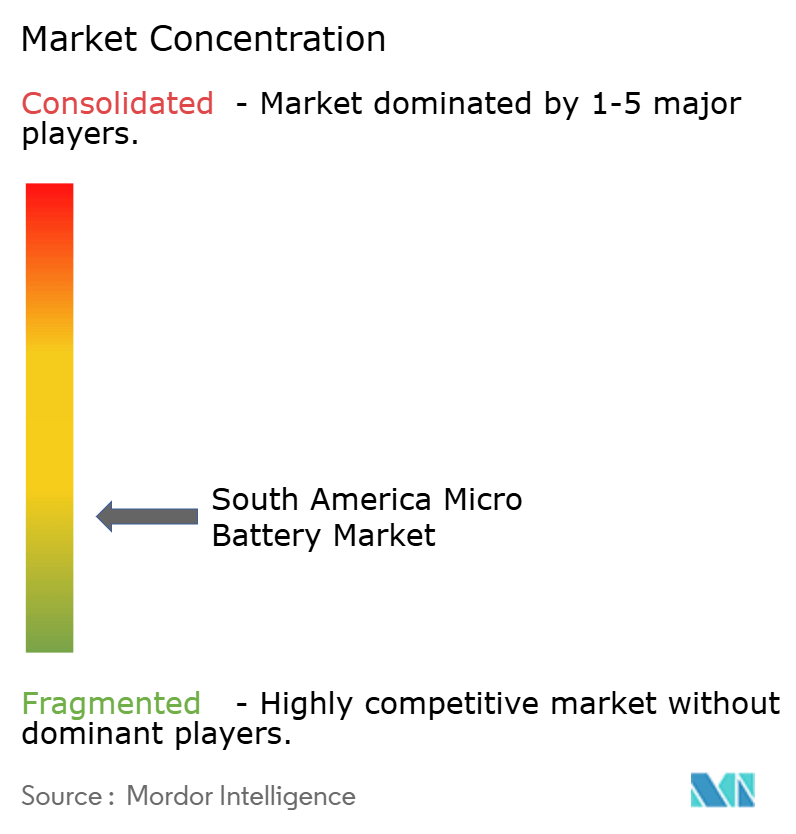
Recent Industry Developments
- March 2024: Eramine Sudamerica inaugurated the first lithium carbonate plant in the northern Argentine province of Salta. The plant is expected to produce 3,000 tons this year and ramp up to 24,000 tons by 2025.
- March 2023: Chery Inc., a Chinese carmaker, intended to build a USD 400 million EV and battery plant in Argentina. Jujuy, one of three lithium-producing areas of Argentina, is likely to make battery cathodes in the province. The company is raising the production of all battery types, including micro batteries.
South America Micro Battery Market Report Scope
Micro batteries are small-sized batteries that are commonly used in small electronic devices such as calculators, remote controls, and watches, as well as in medical devices such as glucose meters and hearing aids.
The South American micro battery market is segmented by Battery Type, Application, and Geography. By battery type, the market is segmented into Thin Film Battery, Solid State Chip Battery, Printed Battery, and Button Battery. By Application, the market is segmented into Consumer Electronics, Medical Devices, Smart Cards, Wireless Sensors, and Others. The report also covers the market size and forecasts for the South America micro battery market across major regions. The Report Offers the Market Size and Forecasts in Revenue (USD) for all the Above.
| Thin Film Battery |
| Solid State Chip Battery |
| Printed Battery |
| Button Battery |
| Consumer Electronics |
| Medical Devices |
| Smart Cards |
| Wireless Sensors |
| Others |
| Primary Battery |
| Secondary Battery |
| Brazil |
| Argentina |
| Colombia |
| Rest of South America |
| By Battery Type | Thin Film Battery |
| Solid State Chip Battery | |
| Printed Battery | |
| Button Battery | |
| By Application | Consumer Electronics |
| Medical Devices | |
| Smart Cards | |
| Wireless Sensors | |
| Others | |
| By Type | Primary Battery |
| Secondary Battery | |
| Geography | Brazil |
| Argentina | |
| Colombia | |
| Rest of South America |
Key Questions Answered in the Report
How big is the South America Micro Battery Market?
The South America Micro Battery Market size is expected to reach USD 75.75 million in 2025 and grow at a CAGR of 9.78% to reach USD 120.78 million by 2030.
What is the current South America Micro Battery Market size?
In 2025, the South America Micro Battery Market size is expected to reach USD 75.75 million.
Who are the key players in South America Micro Battery Market?
Maxell, Ltd, Murata Manufacturing Co., Ltd., Panasonic Holding Corporation, Duracell Inc. and Varta AG are the major companies operating in the South America Micro Battery Market.
What years does this South America Micro Battery Market cover, and what was the market size in 2024?
In 2024, the South America Micro Battery Market size was estimated at USD 68.34 million. The report covers the South America Micro Battery Market historical market size for years: 2019, 2020, 2021, 2022, 2023 and 2024. The report also forecasts the South America Micro Battery Market size for years: 2025, 2026, 2027, 2028, 2029 and 2030.
Page last updated on:
South America Micro Battery Market Report
Statistics for the 2025 South America Micro Battery market share, size and revenue growth rate, created by Mordor Intelligence™ Industry Reports. South America Micro Battery analysis includes a market forecast outlook for 2025 to 2030 and historical overview. Get a sample of this industry analysis as a free report PDF download.
